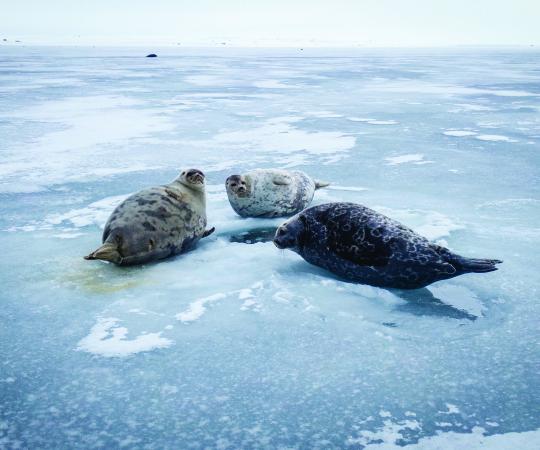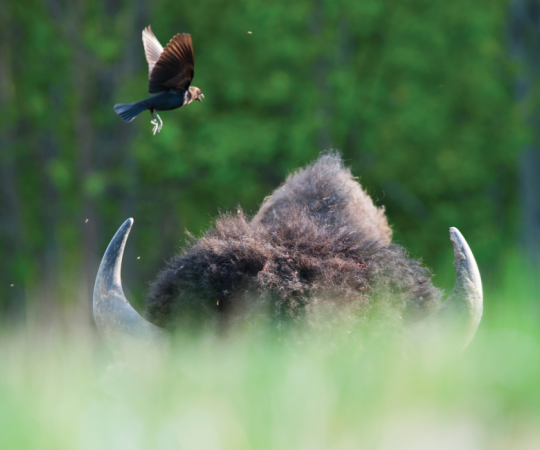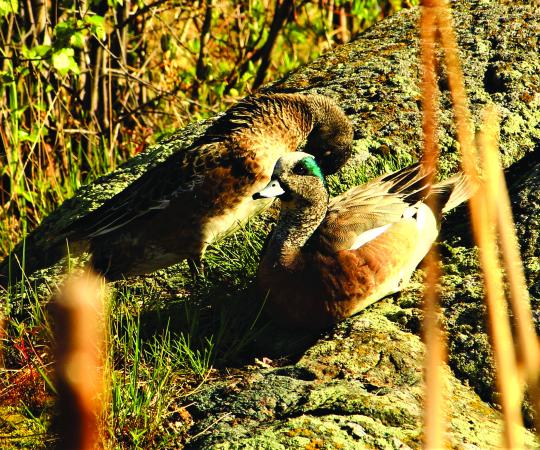Slowing for a traffic light one late-summer evening near the Yellowknife Walmart of all places, a red fox burst out of the bushes at the side of the road, followed by five young kits—three red, one grey-red with dark markings, and one black.
I held the brake down as they scooted practically under the car in front of me, up on the esplanade, and then across two more lanes of traffic to fetch up on the corner. One kit ran up to the mother and jumped at her face, and two others tumbled about in the grass. All this while surrounded by vehicles, with people bicycling along the sidewalk.
I caught some movement in the underbrush. It was another kit, left behind. He scurried halfway across the street, chickened out, crouched low, then spun and ran back. The light changed, and traffic moved on. I had to follow, but I wondered all evening what happened to that lonely little pup. Did he find his family? Were there more kits in the brush? Would he survive?
Actually, it’s quite likely he’s okay. Foxes—and the red fox in particular—are becoming a common site in urban environments. And why not? They can hunt the back lanes and road margins in the city, snacking on dropped delicacies like KFC chicken legs, and perhaps small birds leaving the nest too early, and later nibbling on berries, and rose hips.
Yellowknife offers rich pickins for red foxes. They quickly learn how to judge traffic and slip across the roads, tails floating, bouncing into the grassy verges and on up onto the rock outcrops.
In winter, their dot-dot-dot tracks lace through the snow along roads and trails. You may see one loping across a snowy lake, dashing across a trail right before a dogteam approaches. They trot, bold as brass, through backyards, pausing to hunt voles, strolling across porches, and into dog lots. One regularly sleeps atop dog houses near where I live. Another steals any glove left outside. Somewhere, there is a cache of gloves!
Foxes can also be real pests at exploration camps and remote cabins, chewing through floors of buildings during the winter to get at the grease that can accumulate under stoves—and opening up an entrance that often later allows wolverines to enter.
That’s why you should never feed them. A few years back, as I sat on a pile of pallets at a gold exploration project, waiting for a helicopter, I was approached by four young Arctic foxes. They darted this way and that—looking, peering, sniffing. They did not appear to be afraid. Suddenly, something rolled into their vicinity. One fox dashed over and grabbed it, then swirled away down into rows of core boxes. It was a breakfast sausage. A group of drillers, sitting on the steps, were tossing treats to the foxes.
These little foxes had no fear at all. Feeding wildlife is illegal and against the rules of any exploration camp, and the guys were setting themselves up for a number of unpleasant experiences—a bite (how does a little fox tell the difference between a breakfast sausage and a human finger?), possible exposure to rabies, or the destruction of clothing and supplies. In the end, the foxes pay the ultimate price, as they need to be removed—usually with a bullet. I stamped my feet and tossed a rock toward the young foxes, and they dashed off down into the core boxes.
Although they appear playful and approachable, in general, foxes do not make good pets. They are nervous, high-energy and often snappish, which makes them particularly dangerous around children.
Foxes are members of the family Canidae. In general, the canids are runners, with relatively long legs. They also have a well-developed ability to hunt by scent, based on long noses with complex turbinate bones, covered with mucus membranes filled with blood vessels. These warm the cold air inhaled while running.
Foxes are active all year, meaning they do not hibernate. In North America, canids like foxes and wolves live far into the high Arctic islands. They are carnivores, living predominantly
on meat.
There are two fox species in the North, the red fox and arctic fox. These are very different, but both are highly adaptable and flexible. Neither is a pack animal, though families will hunt together for a while. But the two species are not friendly with each other. In the North, the red fox hunts the arctic fox, with young ones and adults going into the burrows and wiping out entire families.
Red foxes
Red foxes (Vulpes vulpes) are larger than arctic foxes, and typically associated with forested areas, even though they do overlap into tundra. Red foxes have a wide distribution worldwide, throughout the Northern Hemisphere, and into Africa, north of the Sahara—even Australia.
Extremely adaptable, red foxes can occupy a variety of habitats. They prefer living at the forest edges, and will move into cities where they confidently patrol backyards and parks, golf courses, and powerline and railroad corridors.
Much of their adaptability is attributable to their diets. Most red foxes are considered to be omnivorous—they eat anything, from fruits, berries and some roots to small mammals, birds, bird’s eggs and insects, earthworms, crustaceans, reptiles and amphibians.
Like arctic foxes, red foxes avidly hunt small animals. They listen for the movement of mice, voles or lemmings in dense grass or under snow, and leap into the air to descend on the hapless rodent with both front feet extended, reaching down to snap it up. If not feeding young, they gulp the mouse down in one bite. In the arctic, both species of fox scavenge caribou carcasses, clean up expelled placentas during calving season and eat any stillborn calves. They can do devastating damage to colonies of nesting gulls or geese, feeding on the eggs or young until they are all gone.
Many red foxes are monogamous during the breeding season, and some partners remain together as a mated pair year-round. They can dig burrows but often use the burrows of other animals like groundhogs or other secluded and protected sites, around houses and under porches. This is especially true where the red fox range overlaps with coyotes. Red foxes also den in hollows in trees, under rock overhangs or in dense bushes. As the kits grow, their parents bring injured animals to them to teach them how to kill. By late summer, the young foxes accompany the parents on hunting expeditions.
Foxes hunt all year and store food in their dens or nearby caches. They are generally out in all weather, except the most severe storms. Their double coats are highly efficient, and a fox can curl up in the shelter of a snowbank or cliff, wrap itself in its fluffy tail, and sleep away the storm.
Red foxes occur in several colour morphs, all of which may be found in one litter. Most common is the red morph, with some variation in intensity of red. Then there is the darker cross fox morph, with darker red and brown or black markings over the shoulders and back. The rarer silver fox morph shows a black background with white hairs interspersed, varying from entirely black to a frosted silver colour. In all cases, red foxes have white tipped tails.
The plasticity of colour inheritance in red foxes has led to much intentional breeding for the fur industry and the development of a huge variety of colours and patterns, from almost entirely white to cream, mottled, variations of black, amber, blue, pearl, and a fascinating reddish crystal colour, popular in Nunavut.
Arctic foxes
Arctic foxes (Alopex lagopus) are smaller than red foxes with a shorter face and short fluffy ears. Lagopus means “hare-footed,” as their feet are fully furred on the bottom in winter, like arctic hares. This fur is thought to insulate and help keep them from slipping on ice.
Their coat (or pelage) changes with the seasons. Most are snowy white or light silvery grey in winter, and brown and tan in summer. In spring, they shed the winter coat in huge tufts, revealing the dark brown hair of the summer coat, so the fox appears piebald for a while.
There are a couple of colour ecotypes in arctic foxes. Lemming foxes are white in winter, brown in summer, and live mostly on land or on sea ice. The coastal fox is a deep blue-grey year-round, and slightly lighter in summer. They live in coastal areas with steep cliffs and feed mostly on tidal invertebrates and cliff-nesting bird eggs and young.
Arctic foxes tend to be more carnivorous than red foxes, eating small mammals (voles, lemmings, arctic ground squirrels) up to the size of a hare. They also eat small perching birds, ptarmigan, ducks, and geese, bird’s eggs, insects, and small invertebrates in the tidal zone like fish, mollusks, crabs, sea urchins. Arctic foxes often follow polar bears, feeding on the remains of their kills. They also scavenge around human habitations, eating scraps from butchered animals and all sorts of discarded items. I have seen an arctic fox elevate six feet and disappear into a trash bin—only to be followed moments later by another—in the search for food.Arctic foxes occasionally learn how to kill newborn ringed seals in their natal dens—called agluit. They scent the seal, and dig down, biting it in the face and around the head. The baby seal’s skull is thin, so the fox can easily get to the brain for a quick kill. The mother does not try to defend her young, instead diving down her entrance hole into the safety of the sea.
Arctic foxes are sometimes called little “ecosystem engineers.” Traditional den sites are occupied by a succession of generations. This constant use, aeration of the soil, and deposit of nutrients can change the local environment. Tall grasses, willows and other bushes, alpine arnica, star chickweed and a variety of mustards grow on the den mounds, and they are recognizable from a distance due to the luxuriant growth. If the terrain and soil allow it, an arctic fox den can be amazingly complex, with a system of tunnels, sleeping chambers, and entrances and exits—sometimes dozens in a single system.
The range of the arctic fox is circumpolar, from the south end of Hudson Bay and southern Labrador, and, in the west, down into the Aleutian Islands, all across northern Siberia and Russia and into the northern parts of Scandinavia, Svalbard and Greenland. The arctic fox is the only native land mammal in Iceland.
Arctic foxes are mobile, and can move long distances in their lifetimes. One study from the Norwegian Polar Institute (Fuglei, Eva, and Arnaud Tarroux, 2019) outfitted a young female arctic fox with a GPS transmitter. That fox travelled 3,500 km from Spitzbergen across the sea ice to Greenland, then across the Greenland ice sheet and Ellesmere Island to near Eureka and Greely Fiord in 76 days. Her longest run was 155 km in one day across the ice sheet. This coastal fox’s diet changed during this migration: it fed on coastal invertebrates and cliff-nesting birds at first and then lemmings and other small mammals.
Arctic foxes undergo great periodic fluctuations in numbers, following population irruptions of voles or lemmings. Arctic fox litters usually average five to seven cubs, born in May or June. More are often born, but die due to a lack of food or by predation from the stronger ones. However, in rich lemming years, litters are much larger—15 to 20 cubs are not unusual.
This means arctic fox populations can grow at amazing rates. Though born blind and hairless, cubs develop quickly. By two weeks of age, they are being weaned and eating solid food provided by the parents. By late summer, they are living on their own. When prey populations crash, fox populations do too. That explains why there are years in which arctic foxes seem to be everywhere, followed by years where only a few are seen.









